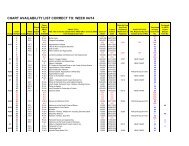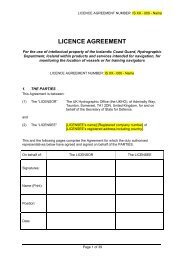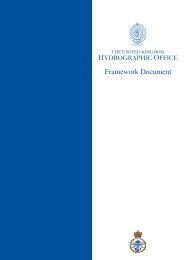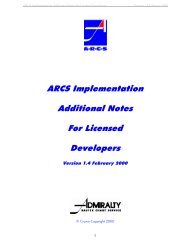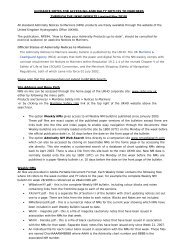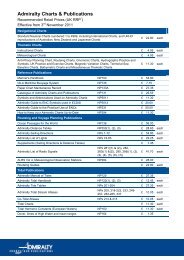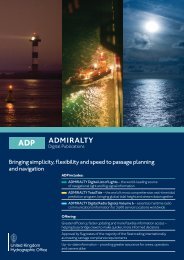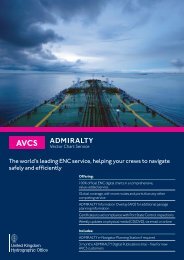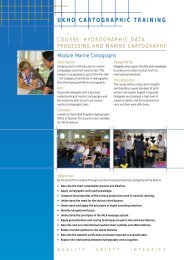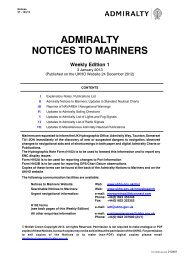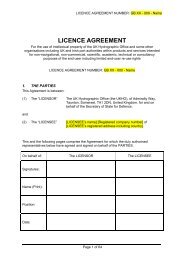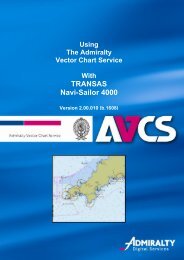EA10 Approaches to Lowestoft - United Kingdom Hydrographic Office
EA10 Approaches to Lowestoft - United Kingdom Hydrographic Office
EA10 Approaches to Lowestoft - United Kingdom Hydrographic Office
You also want an ePaper? Increase the reach of your titles
YUMPU automatically turns print PDFs into web optimized ePapers that Google loves.
THE UNITED KINGDOM<br />
HYDROGRAPHIC OFFICE<br />
EAST ANGLIA<br />
APPROACHES TO LOWESTOFT<br />
ASSESSMENT ON THE ANALYSIS OF ROUTINE RESURVEY AREA <strong>EA10</strong><br />
FROM THE 2005 SURVEY<br />
FEBRUARY 2006
THE UNITED KINGDOM<br />
HYDROGRAPHIC OFFICE<br />
EAST ANGLIA<br />
APPROACHES TO LOWESTOFT<br />
Assessment <strong>EA10</strong>/2005<br />
An assessment of the 2005 hydrographic survey of the area: <strong>to</strong> moni<strong>to</strong>r recent seabed<br />
movement; <strong>to</strong> identify any implications for shipping; and <strong>to</strong> make recommendations for<br />
future surveys.<br />
The Admiralty Chart extracts, other graphics and tables in this Report are included for illustrative purposes<br />
only and are NOT TO BE USED FOR NAVIGATION.<br />
This material is protected by Crown Copyright. It may be downloaded from the UK <strong>Hydrographic</strong> <strong>Office</strong>'s (UKHO) web site and printed in<br />
full for personal or non-commercial internal business use. Extracts may also be reproduced for personal or non-commercial internal<br />
business use on the condition that the UK <strong>Hydrographic</strong> <strong>Office</strong> is acknowledged as the publisher and the Crown is acknowledged as the<br />
copyright owner.<br />
Applications for permission <strong>to</strong> reproduce the material for any other purpose (including any distribution of the material or extracts <strong>to</strong> third<br />
parties) can be made interactively on the UKHO's web site (www.ukho.gov.uk), by e-mail <strong>to</strong> intellectualproperty@ukho.gov.uk or in<br />
writing <strong>to</strong> Intellectual Property, UK <strong>Hydrographic</strong> <strong>Office</strong>, Admiralty Way, Taun<strong>to</strong>n, Somerset, TA1 2DN.<br />
Assessment <strong>EA10</strong>/2005 – Original Page 1 of 20
CONTENTS<br />
1. EXECUTIVE SUMMARY 3<br />
2. INTRODUCTION 4<br />
3. HISTORY 4<br />
4. DESCRIPTION OF THE AREA 5<br />
5. SHIPPING IN THE AREA 5<br />
6. 2004 SURVEY DETAILS 6<br />
7. 2005 SURVEY DETAILS 7<br />
8. DESCRIPTION OF RECENT BATHYMETRIC CHANGE 7<br />
9. IMPLICATIONS FOR SHIPPING 8<br />
10. RECOMMENDATIONS FOR FUTURE SURVEYS 8<br />
11. REFERENCES 9<br />
ANNEXES<br />
A. Area Specifications (Including Survey His<strong>to</strong>ry) 10<br />
B. Location Plot and Diagrammatic Representation of Ships' Tracks from COAST v6.1 11<br />
C. 2005 Survey Data Overlaid on Chart 1536 12<br />
D. Three Dimensional View Generated from the 2005 Survey Data 13<br />
E. Sun Illuminated View of the 2005 Survey and Location of Cross Sections Shown 14<br />
At Annex F<br />
F. Cross Sections from the 2005 Survey 15<br />
G. Colour Banded Depth Plot from the 2004 Survey showing Selected Depths 16<br />
H. Colour Banded Depth Plot from the 2005 Survey showing Selected Depths 17<br />
I. Variability Plot showing Bathymetric Changes between the 2004 and 2005 18<br />
Survey Data and Charted Con<strong>to</strong>urs from the 2005 Survey<br />
J. Composite Diagram of the 5 metre Con<strong>to</strong>ur from the 2004 and 2005 Surveys 19<br />
K. Composite Diagram of the 10 metre Con<strong>to</strong>ur from the 2004 and 2005 Surveys 20<br />
Assessment <strong>EA10</strong>/2005 – Original Page 2 of 20
APPROACHES TO LOWESTOFT, 2005<br />
1. EXECUTIVE SUMMARY<br />
The Area and Recent Changes<br />
1.1 A focused area within <strong>EA10</strong> is surveyed on an annual cycle and includes Stanford Channel,<br />
which provides the main approach <strong>to</strong> Lowes<strong>to</strong>ft Harbour from the south. The full area,<br />
which includes the adjacent banks, is surveyed on a 3 year cycle. The 2005 survey was<br />
the second routine resurvey of the area using a multibeam echosounder.<br />
1.2 Depths in the final approach <strong>to</strong> Lowes<strong>to</strong>ft, including the area of The Ridge, and across the<br />
seaward entrance <strong>to</strong> Stanford Channel, where there is an area of sandwaves, are<br />
potentially limiting <strong>to</strong> shipping. Vessels with draughts of up <strong>to</strong> 7 metres are unders<strong>to</strong>od <strong>to</strong><br />
use Stanford Channel, with vessels up <strong>to</strong> 6 metres commonly berthing in Lowes<strong>to</strong>ft Inner<br />
Harbour.<br />
1.3 The minimum depth in the entrance <strong>to</strong> Stanford Channel has increased from 6.0 metres <strong>to</strong><br />
6.3 metres when compared against the 2004 survey and sandwaves have migrated<br />
southwards by approximately 75 metres.<br />
1.4 A sandwave previously lying close north of Southwest Holm buoy has a similar minimum<br />
depth, but now lies immediately southeast of the buoy.<br />
1.5 The 5 metre con<strong>to</strong>ur delimiting Holm Sand has extended southwards slightly, but remains<br />
outside the buoyed channel.<br />
1.6 Depths throughout the rest of the area remain broadly similar. A shoal depth of 1.9<br />
metres exists on the edge of the survey area, <strong>to</strong> the southeast of the entrance <strong>to</strong><br />
Lowes<strong>to</strong>ft Harbour. This reflects a shoaling <strong>to</strong> a ridge which extends in<strong>to</strong> the area, a<br />
charted depth of 1.3 metres exists over this ridge outside the focused survey area.<br />
Reasons for Continuing <strong>to</strong> Resurvey the Area<br />
1.7 Stanford Channel provides a buoyed approach <strong>to</strong> the port of Lowes<strong>to</strong>ft. The following<br />
areas require frequent resurveying due <strong>to</strong> changes occurring -<br />
• the shoal ridge and sandwaves at the entrance <strong>to</strong> Stanford Channel are of most<br />
concern and required annual surveying;<br />
• the remainder of the approach appears more stable and contains fewer mobile<br />
features, as such the requirement for annual surveying needs further<br />
consideration;<br />
• the adjacent banks of Newcome Sand and Holm Sand are mobile, but outside the<br />
buoyed channel and require less frequent surveying.<br />
Recommendations<br />
1.8 Much of Stanford Channel is generally stable and, away from the area of sandwaves at the<br />
entrance <strong>to</strong> the channel, there is potential for reducing the requirement for annual<br />
resurveying. Although 2 multibeam surveys of the focused area are available and have<br />
been examined in this report, with previous reports also consulted, it is considered that a<br />
more extensive examination of his<strong>to</strong>rical data is undertaken when the 2006 survey,<br />
covering the full area, is assessed. Inclusion of a third multibeam data set will also<br />
provide a better indication of trends occurring in the area.<br />
Assessment <strong>EA10</strong>/2005 – Original Page 3 of 20
1.9 The limits and frequency should remain unchanged at present.<br />
2.<br />
INTRODUCTION<br />
2.1 This Assessment is produced by the <strong>United</strong> <strong>Kingdom</strong> <strong>Hydrographic</strong> <strong>Office</strong> (UKHO) for the<br />
Maritime and Coastguard Agency (MCA).<br />
2.2 Analysis of the Routine Resurvey Areas forms part of the Civil Hydrography Programme<br />
and the reports are distributed <strong>to</strong> members of the Committee On Shipping Hydrography<br />
(COSH). When approved by the annual COSH meeting and endorsed by the Civil<br />
<strong>Hydrographic</strong> Review Committee (CHRC), the recommendations are incorporated in<strong>to</strong> the<br />
Routine Resurvey Programme. The report is governed by a Memorandum of<br />
Understanding between the DfT (including the MCA) and the MOD (including the UKHO).<br />
3.<br />
HISTORY<br />
3.1 <strong>EA10</strong> is one of the routine resurvey areas of the East Anglian Routine Resurvey<br />
Programme, which covers the approaches <strong>to</strong> the East Anglian ports of Great Yarmouth and<br />
Lowes<strong>to</strong>ft.<br />
3.2 Prior <strong>to</strong> 1980 the area that includes <strong>EA10</strong> was designated as areas A and B. These<br />
covered an area extending from Holm Sand in the north via Pakefield Road <strong>to</strong> Barnard in<br />
the south.<br />
3.3 In 1980 areas A and B were reorganised with changed limits and given the identifiers C1<br />
and C3. These had an annual and 3 year survey interval respectively.<br />
3.4 The 1994 report on C1 and C3 radically altered the limits, removing C3 from the<br />
programme, although parts of C3 were subsumed within other areas. In 1997 C1 was<br />
given the identifier <strong>EA10</strong>, with unchanged limits and survey interval.<br />
3.5 Following assessment of the 2001 survey, the area limits were revised <strong>to</strong> better focus on<br />
areas of concern <strong>to</strong> shipping. The southwest part of the area was transferred <strong>to</strong> EA12, and<br />
the southern limit was extended <strong>to</strong> take account of sediment transport along Newcome<br />
Sand.<br />
3.6 At a Working Group meeting convened after the 2002 Committee on Shipping<br />
Hydrography (COSH) meeting, it was agreed that for the 2003 survey <strong>EA10</strong> would be fully<br />
surveyed <strong>to</strong> IHO Order 1 Standard between the 5 metre and 15 metre con<strong>to</strong>urs. Over the<br />
banks, survey lines were <strong>to</strong> be opened up <strong>to</strong> 150 metre line spacing and sounding-only<br />
lines run <strong>to</strong> moni<strong>to</strong>r the stability/movement of these banks.<br />
3.7 Subsequent <strong>to</strong> conducting the 2004 survey, new limits and survey regime for <strong>EA10</strong> were<br />
proposed. This consisted of a survey of the full area on a 3-year cycle, but with reduced<br />
limits, and a focused survey, restricting surveying <strong>to</strong> the channels on the intervening<br />
years. The 2004 survey was conducted as a focused survey of the main channel, covering<br />
the approach <strong>to</strong> Lowes<strong>to</strong>ft.<br />
3.8 This is the tenth Assessment on the area. A Report covering multiple surveys was<br />
published in 1994.<br />
3.9 Trinity House Lighthouse Service (THLS) also conducts surveys of Stanford Channel.<br />
These are unders<strong>to</strong>od <strong>to</strong> generally conducted at about 6 monthly intervals; the frequency<br />
of these surveys has been extended, initially from quarterly <strong>to</strong> every 4 months (1997) and<br />
then <strong>to</strong> every 6 months (1998). However, the latest surveys held by the UKHO were<br />
Assessment <strong>EA10</strong>/2005 – Original Page 4 of 20
conducted in May 2003 (whole of Stanford Channel surveyed) and December 2004<br />
(entrance <strong>to</strong> Stanford Channel).<br />
4. DESCRIPTION OF THE AREA<br />
4.1 <strong>EA10</strong> covers Stanford Channel and final approach <strong>to</strong> Lowes<strong>to</strong>ft, and the focused area<br />
surveyed in 2005 covered 1.69 SQ NM (5.8 SQ KM).<br />
4.2 Stanford Channel, which is buoyed, effectively bisects <strong>EA10</strong> and separates the shoal areas<br />
of Holm Sand and Newcome Sand. Stanford Channel provides the main approach route <strong>to</strong><br />
Lowes<strong>to</strong>ft Harbour from the south. The channel was buoyed and opened up <strong>to</strong> shipping in<br />
1994, at which time the controlling depth across the entrance was 4.6 metres. At the<br />
same time, buoys marking Pakefield Road and Lowes<strong>to</strong>ft South Road were discontinued.<br />
Depths of 6.3 metres and greater were found across the entrance <strong>to</strong> the channel in the<br />
2005 survey.<br />
4.3 The potentially limiting depths in the area are those on the final approach <strong>to</strong> Lowes<strong>to</strong>ft,<br />
including those over The Ridge, lying <strong>to</strong> the northeast of Lowes<strong>to</strong>ft Harbour entrance and<br />
those across the seaward entrance <strong>to</strong> Stanford Channel. A channel dredged <strong>to</strong> 4.7 metres<br />
lies inside the harbour entrance.<br />
4.4 The seabed sediments comprise of mud, fine sand, sand, pebbles and broken shell.<br />
Southward migrating sandwaves lie within the flood dominant Stanford Channel,<br />
predominantly at the entrance <strong>to</strong> the channel and along the western side of Holm Sand.<br />
The final approach <strong>to</strong> Lowes<strong>to</strong>ft Harbour is made up of extensive small sand ripples, with<br />
ripples of up <strong>to</strong> 0.3 metres on the southern side of the channel. A small area of<br />
sandwaves up <strong>to</strong> 1.5 metres in height lies at the entrance <strong>to</strong> the channel.<br />
4.5 Area specifications, including the survey his<strong>to</strong>ry, are at Annex A and limits are shown at<br />
Annex B.<br />
5. SHIPPING IN THE AREA<br />
5.1 During recent surveys a moderate flow of commercial shipping has been observed <strong>to</strong><br />
transit <strong>EA10</strong>. These were North Sea oil and gas installation support vessels and medium<br />
sized coasters. Additionally a small number of fishing vessels operate within <strong>EA10</strong> and<br />
recreational sailing vessels are seen, particularly at the weekend.<br />
5.2 Vessels up <strong>to</strong> 6 metres draught can normally berth in Lowes<strong>to</strong>ft Inner Harbour, although<br />
vessels up <strong>to</strong> 6.5 metres are accommodated subject <strong>to</strong> available tide and suitable weather<br />
conditions. Vessels with draughts of up <strong>to</strong> about 7 metres are unders<strong>to</strong>od <strong>to</strong> anchor<br />
outside the harbour, usually <strong>to</strong> shelter from inclement weather.<br />
5.3 The main approach <strong>to</strong> Lowes<strong>to</strong>ft Harbour is through Stanford Channel. Lowes<strong>to</strong>ft South<br />
Road and Pakefield Road <strong>to</strong> the west of the area provide inshore access from the south for<br />
fishing vessels and are used by the occasional small coaster of less than 1,000 <strong>to</strong>nnes and<br />
drawing no more than 2 metres en route through the area. Lowes<strong>to</strong>ft North Road is very<br />
rarely used as a passage for shipping, with only a small number of standby vessels, with<br />
drafts below 3 metres, regularly using Lowes<strong>to</strong>ft North Road and Cor<strong>to</strong>n Road further<br />
north.<br />
5.4 A search of the COAST database v6.1, based on a 1.7 nautical mile radius centred on<br />
52° 27’.4N 1° 46’.5E (see Annex B), shows an estimate of 678 vessels per annum<br />
transiting the search area. The statistics use a common destination point off Great<br />
Yarmouth for the ports of Great Yarmouth and Lowes<strong>to</strong>ft. As such, the data is of little use<br />
in determining actual shipping patterns within the area.<br />
Assessment <strong>EA10</strong>/2005 – Original Page 5 of 20
Type DWT Total<br />
< 1,500 112<br />
Merchant 1,500 – 5,000 422<br />
>5,000 24<br />
Tankers<br />
< 5,000 92<br />
> 5,000 0<br />
< 1,500 20<br />
RORO >1,500 0<br />
Container<br />
< 1,500 0<br />
1,500 - 5,000 8<br />
Total: 678<br />
5.5 The following figures provided by the Port of Lowes<strong>to</strong>ft detail arrivals at the port in 2003<br />
and 2004.<br />
Vessel Type 2003 2004<br />
Container 52 12<br />
Tankers 7 3<br />
Cargo 130 115<br />
Standby 182 148<br />
Research/Barges 341 388<br />
Tugs 176 180<br />
Deep Sea Fishing 89 47<br />
Inshore Fishing 2,012 1,810<br />
Total: 2,989 2,703<br />
6. 2004 SURVEY DETAILS<br />
6.1 The survey was conducted from 25 May <strong>to</strong> 09 June. Weather in the area remained good<br />
while on survey task with the exception of three days where the weather picked up forcing<br />
the vessel <strong>to</strong> return alongside Lowes<strong>to</strong>ft.<br />
6.2 This survey was conducted using a dual head Kongsberg Maritime EM3000D multibeam<br />
echosounder. The system forms 127 beams from each sonar head, giving a <strong>to</strong>tal of 254<br />
beams, but with an overlap in swaths in the nadir region. Survey lines were run at 50<br />
metre intervals, with object detection criteria met with the multibeam echosounder. Cross<br />
lines were run in accordance with survey instructions. The survey achieved IHO S44<br />
Order 1 standard.<br />
6.3 Positioning was by DGPS and the survey referred <strong>to</strong> the International Terrestrial Reference<br />
Framework 2000 (ITRF2000) Datum. The survey achieved a horizontal accuracy of ±1.7<br />
metres (2σ).<br />
6.4 The data was processed using Kongsberg Neptune v4.1 and shoalest depths from 2 metre<br />
cells were extracted, retaining the observed depths in their true positions.<br />
6.5 The accuracy of depth measurements at nadir was assessed as 0.17 metres with the error<br />
increasing <strong>to</strong> 0.5 metres at the outer beams. Details are as follows:<br />
Assessment <strong>EA10</strong>/2005 – Original Page 6 of 20
Depth in metres<br />
5 10 15<br />
Combined Total Error at Nadir (2σ) 0.17 0.17 0.17<br />
Requirement (2σ) 0.50 0.52 0.54<br />
7. 2005 SURVEY DETAILS<br />
7.1 The survey was conducted from 24 <strong>to</strong> 26 May. Weather in the area remained good during<br />
the period. Shoal areas were surveyed during periods of high tide and slight seas so that<br />
lift was kept <strong>to</strong> a minimum.<br />
7.2 This survey was conducted using a dual head Kongsberg Maritime EM3000D multibeam<br />
echosounder. The survey achieved IHO S44 Order 1 standard.<br />
7.3 Positioning was by DGPS and the survey referred <strong>to</strong> the International Terrestrial Reference<br />
Framework 2000 (ITRF2000) Datum. The survey achieved a horizontal accuracy of ±0.9<br />
metres (2σ).<br />
7.4 The data was processed using Caris HIPS v5.4 and shoalest depths from 2 metre cells<br />
were extracted, retaining the observed depths in their true positions.<br />
7.5 The assessed accuracy of depth measurements at nadir met the required standard.<br />
Details are as follows:<br />
Depth in metres<br />
5 10 15<br />
Combined Total Error at Nadir (2σ) 0.13 0.14 0.15<br />
Requirement (2σ) 0.50 0.52 0.54<br />
7.6 The survey data draped over chart 1536 is shown at Annex C and a three-dimensional<br />
view is also shown at Annex D, showing the main features of <strong>EA10</strong>. A sun illuminated<br />
view of the 2005 survey, showing the location of cross sections is at Annex E and the<br />
cross sections are shown at Annex F.<br />
8. DESCRIPTION OF RECENT BATHYMETRIC CHANGE<br />
8.1 Colour banded depth plots of the 2004 and 2005 surveys are at Annexes G and H. A<br />
variability plot showing depth differences between the 2004 and 2005 surveys is at Annex<br />
I.<br />
8.2 Comparison plots of the 5 and 10 metre con<strong>to</strong>urs are at Annexes J and K respectively.<br />
8.3 The minimum depth within the buoyed entrance <strong>to</strong> Stanford Channel has increased from<br />
6.0 metres in 2004 <strong>to</strong> 6.3 metres in 2005. This follows a reduction in depth from 6.6<br />
metres <strong>to</strong> 6.0 metres between the 2003 and 2004 surveys. This depth lies on one of the<br />
sandwaves which lie across the entrance <strong>to</strong> the channel. These sandwaves are migrating<br />
southwards through the flood dominant channel. This will result in changes <strong>to</strong> both the<br />
height and position of the shallowest depth as the sandwaves move across the ridge at<br />
the channel entrance. Between the 2004 and 2005 surveys these sandwaves have<br />
migrated south by approximately 75 metres.<br />
8.4 The sandwave previously lying close north of Southwest Holm buoy has a similar<br />
minimum depth <strong>to</strong> that surveyed in 2004 (increasing from 5.7 metres <strong>to</strong> 5.8 metres), but<br />
now lies immediately southeast of the charted position of the buoy.<br />
Assessment <strong>EA10</strong>/2005 – Original Page 7 of 20
8.5 The 5 metre con<strong>to</strong>ur delimiting Holm Sand has extended southwards slightly, but remains<br />
outside the buoyed channel.<br />
8.6 Depths throughout the rest of the area remain broadly similar. Depths over the shoal<br />
patch <strong>to</strong> the east of North Newcome buoy are shoaler by around 0.1 metres, but the<br />
differences are well within survey <strong>to</strong>lerances. Six hundred metres the southwest of this<br />
shoal area there is a new shoal depth of 1.9 metres. This reflects a shoaling <strong>to</strong> a ridge<br />
which extends in<strong>to</strong> the area, a charted depth of 1.3 metres exists over this ridge outside<br />
the focused survey area.<br />
8.7 A provisional Notice <strong>to</strong> Marines was issued (3757(P)/05) advising of changes <strong>to</strong> depths on<br />
Chart 1536.<br />
9.<br />
IMPLICATIONS FOR SHIPPING<br />
9.1 Changes that have occurred within the area are not of immediate concern <strong>to</strong> shipping<br />
using the buoyed channel and approach <strong>to</strong> Lowes<strong>to</strong>ft.<br />
9.2 Ongoing migration of sandwaves and changes in their minimum depths at the entrance <strong>to</strong><br />
Stanford Channel are of potential concern <strong>to</strong> shipping, in particular the sandwave close <strong>to</strong><br />
South Holm buoy.<br />
9.3 Much of the northern area is devoid of mobile bedforms and the need <strong>to</strong> resurvey the area<br />
annually requires careful consideration.<br />
10.<br />
RECOMMENDATIONS FOR FUTURE SURVEYS<br />
10.1 Much of Stanford Channel is generally stable and, away from the area of sandwaves at the<br />
entrance <strong>to</strong> the channel, there is potential for reducing the requirement for annual<br />
resurveying with 100% multibeam cover. Although 2 multibeam surveys have been<br />
examined in this report and previous reports consulted, it is considered that a more<br />
extensive examination of his<strong>to</strong>rical data is undertaken when the 2006 survey of the full<br />
area is assessed. Inclusion of a third multibeam data set will also provide a better<br />
indication of trends occurring in the area.<br />
10.2 The survey limits and frequency should remain unchanged at present.<br />
Assessment <strong>EA10</strong>/2005 – Original Page 8 of 20
11. REFERENCES<br />
11.1 Safetec Nordic AS, 2005: COAST Database v6.1.<br />
11.2 HR Wallingford, 2002: Southern North Sea Sediment Transport Study, Phase 2.<br />
11.3 <strong>United</strong> <strong>Kingdom</strong> <strong>Hydrographic</strong> <strong>Office</strong>, 2004: Report of Survey, <strong>Approaches</strong> <strong>to</strong> Lowes<strong>to</strong>ft<br />
(M4158).<br />
11.4 <strong>United</strong> <strong>Kingdom</strong> <strong>Hydrographic</strong> <strong>Office</strong>, 2005: Report of Survey, <strong>Approaches</strong> <strong>to</strong> Lowes<strong>to</strong>ft<br />
(M4268).<br />
11.5 <strong>United</strong> <strong>Kingdom</strong> <strong>Hydrographic</strong> <strong>Office</strong>, 2005: <strong>Approaches</strong> <strong>to</strong> Lowes<strong>to</strong>ft, Assessment of<br />
Routine Resurvey Area <strong>EA10</strong> from the 2004 Survey.<br />
11.6 <strong>United</strong> <strong>Kingdom</strong> <strong>Hydrographic</strong> <strong>Office</strong>, 2003: NP54 North Sea (West) Pilot, Sixth Edition.<br />
Assessment <strong>EA10</strong>/2005 – Original Page 9 of 20
ANNEX A<br />
AREA SPECIFICATIONS<br />
(Including Survey His<strong>to</strong>ry)<br />
REGION: East Anglia NAME: <strong>Approaches</strong> <strong>to</strong> Lowes<strong>to</strong>ft AREA: <strong>EA10</strong><br />
LIMITS:<br />
Area co-ordinates are<br />
referred <strong>to</strong> WGS84 Datum<br />
1yr interval<br />
A 52°29’.00N 1°45’.72E<br />
B 52°29’.00N 1°47’.10E<br />
C 52°28’.00N 1°47’.10E<br />
D 52°26’.78N 1°47’.50E<br />
E 52°26’.10N 1°47’.10E<br />
F 52°26’.10N 1°46’.80E<br />
G 52°28.15N 1°46’.30E<br />
H 52°28.15N 1°45’.10E<br />
<strong>to</strong> (A) via the 2m con<strong>to</strong>ur<br />
3yr interval<br />
A 52°29’.00N 1°45’.72E<br />
B 52°29’.00N 1°48’.80E<br />
C 52°26’.60N 1°47’.60E<br />
D 52°26’.60N 1°46’.40E<br />
E 52°28’.00N 1°45’.80E<br />
F 52°28’.00N 1°45’.00E<br />
<strong>to</strong> (A) via the 2m con<strong>to</strong>ur<br />
AREA SIZE:<br />
1.69 SQ NM (5.8 SQ KM) Approx. – 1yr survey interval<br />
3.64 SQ NM (12.51 SQ KM) Approx. – 3yr survey interval<br />
SURVEY INTERVAL: 1/3 yr<br />
SURVEYS: (conducted at 1:25,000 scale (not applicable <strong>to</strong> multibeam surveys))<br />
Year Survey File Ref Data Year Survey File Ref Data<br />
1994 M2261 HH090/624/01 s.d. 2000 M3349 HH090/884/01 s.d.<br />
1995 M2481 HH090/663/01 s.d. 2001 M3542 HH090/941/01 s.d.<br />
1996 M2613 HH090/688/01 s.d. 2002 M3722 HH090/999/01 s.d.<br />
1997 M2814 HH090/735/01 s.d. 2003 M3913 HH090/021/01 s.t.d.<br />
1998 M3007 HH090/767/01 s.d. 2004 M4158 HH091/076/01 m.<br />
1999 M3212 HH090/849/01 s.d. 2005 M4268 HH091/112/01 m.<br />
KEY: s = sonar sweep, t = seabed texture tracing, d = digital data, m = multibeam digital data<br />
REPORTS: 1994 Latest survey included M2261 (HA145/02/03/04)<br />
ASSESSMENTS: 1995 M2481 (HA145/02/003/05) 2001 M3542 (HA145/010/065/01)<br />
1996 M2613 (HA145/010/004/01) 2003 M3722 (HA145/010/077/01)<br />
1997 M2814 (HA145/010/004/01) 2004 M3913 (HA145/010/089/01)<br />
1998 M3007 (HA145/010/004/01) 2005 M4158<br />
1999 M3212 (HA145/010/033/01) 2005 M4268<br />
2000 M3349 (HA145/010/033/01)<br />
REMARKS:<br />
1979 Report on old areas A and B (H1964/77)<br />
1980 Area C1 established (H3912/80)<br />
1993 Change of limits <strong>to</strong> include Newcome Sand up <strong>to</strong> the 10m line. Inshore of the 2m con<strong>to</strong>ur<br />
only <strong>to</strong> be surveyed every 3/6 years. Dept of Transport accepted recommendations on 15<br />
Oct 93 (HA145/02/03/04)<br />
1994 Report amends limits. Dept of Transport accepted recommendations Jul 95<br />
(HA145/02/03/04).<br />
1997 Limits amended. Identifier changed <strong>to</strong> <strong>EA10</strong><br />
2004 Introduction of focused annual surveys<br />
LARGEST SCALE CHART: 1536 (1:20,000 & 1:40,000)<br />
Assessment <strong>EA10</strong>/2005 – Original Page 10 of 20
ANNEX B<br />
LOCATION PLOT<br />
AND<br />
DIAGRAMMATIC REPRESENTATION<br />
OF SHIPS’ TRACKS FROM COAST V6.1<br />
Search Radius 1.7 NM: Centre 52º 27’.4N 1º 46’.5E<br />
EA9<br />
EA8<br />
Lowes<strong>to</strong>ft/Gt Yarm-Willebroek<br />
<strong>EA10</strong><br />
EA12<br />
Key<br />
_____ Limits of Focused Area <strong>EA10</strong> (2005 survey)<br />
_____<br />
Adjacent Routine Resurvey Areas<br />
_____ Search Area<br />
_____<br />
Ships’ Tracks<br />
Assessment <strong>EA10</strong>/2005 – Original Page 11 of 20
2005 SURVEY DATA OVERLAID ON CHART 1536<br />
ANNEX C<br />
Assessment <strong>EA10</strong>/2005 – Original Page 12 of 20
ANNEX D<br />
THREE DIMENSIONAL VIEW GENERATED<br />
FROM THE<br />
2005 SURVEY DATA<br />
Viewed from the South<br />
Vertical Exaggeration x12<br />
Assessment <strong>EA10</strong>/2005 – Original Page 13 of 20
ANNEX E<br />
SUN ILLUMINATED VIEW OF THE 2005 SURVEY<br />
AND<br />
LOCATON OF CROSS SECTIONS SHOWN AT ANNEX F<br />
A<br />
B<br />
C<br />
D<br />
E<br />
Direction of sandwave<br />
Sediment migration transport based on sandwave based<br />
on asymmetry sandwave asymmetry<br />
F<br />
Assessment <strong>EA10</strong>/2005 – Original Page 14 of 20
ANNEX F<br />
CROSS SECTIONS FROM THE 2005 SURVEY<br />
(see Annex E for locations)<br />
A Profile AB B<br />
C Profile CD D<br />
E Profile EF F<br />
Assessment <strong>EA10</strong>/2005 – Original Page 15 of 20
ANNEX G<br />
COLOUR BANDED DEPTH PLOT<br />
FROM THE 2004 SURVEY<br />
SHOWING SELECTED DEPTHS<br />
SCALE 1:40,000<br />
Depths in Metres<br />
0.0 <strong>to</strong> 3.0<br />
3.1 <strong>to</strong> 5.0<br />
5.1 <strong>to</strong> 7.0<br />
7.1 <strong>to</strong> 9.0<br />
9.1 <strong>to</strong> 11.0 Selected shoal depths<br />
11.1 <strong>to</strong> 16.0<br />
Assessment <strong>EA10</strong>/2005 – Original Page 16 of 20
ANNEX H<br />
COLOUR BANDED DEPTH PLOT<br />
FROM THE 2005 SURVEY<br />
SHOWING SELECTED DEPTHS<br />
SCALE 1:40,000<br />
Depths in Metres<br />
0.0 <strong>to</strong> 3.0<br />
3.1 <strong>to</strong> 5.0<br />
5.1 <strong>to</strong> 7.0<br />
7.1 <strong>to</strong> 9.0<br />
9.1 <strong>to</strong> 11.0 Selected shoal depths<br />
11.1 <strong>to</strong> 16.0<br />
Assessment <strong>EA10</strong>/2005 – Original Page 17 of 20
ANNEX I<br />
VARIABILITY PLOT SHOWING<br />
BATHYMETRIC CHANGES BETWEEN THE 2004 AND 2005 SURVEY DATA<br />
AND CHARTED CONTOURS FROM THE 2005 SURVEY<br />
SCALE 1:40,000<br />
Values in Metres<br />
Shoaling<br />
Deepening<br />
4.0 <strong>to</strong> 3.0<br />
3.0 <strong>to</strong> 2.0<br />
2.0 <strong>to</strong> 0.0<br />
0.0 <strong>to</strong> 1.0<br />
1.0 <strong>to</strong> 2.0<br />
2.0 <strong>to</strong> 3.0<br />
Assessment <strong>EA10</strong>/2005 – Original Page 18 of 20
ANNEX J<br />
COMPOSITE DIAGRAM OF THE<br />
5 METRE CONTOUR FROM THE 2004 AND 2005 SURVEYS<br />
SCALE 1:40,000<br />
Year of Survey<br />
_____ 2005<br />
_____ 2004<br />
Assessment <strong>EA10</strong>/2005 – Original Page 19 of 20
ANNEX K<br />
COMPOSITE DIAGRAM OF THE<br />
10 METRE CONTOUR FROM THE 2004 AND 2005 SURVEYS<br />
SCALE 1:40,000<br />
Year of Survey<br />
_____ 2005<br />
_____ 2004<br />
Assessment <strong>EA10</strong>/2005 – Original Page 20 of 20



